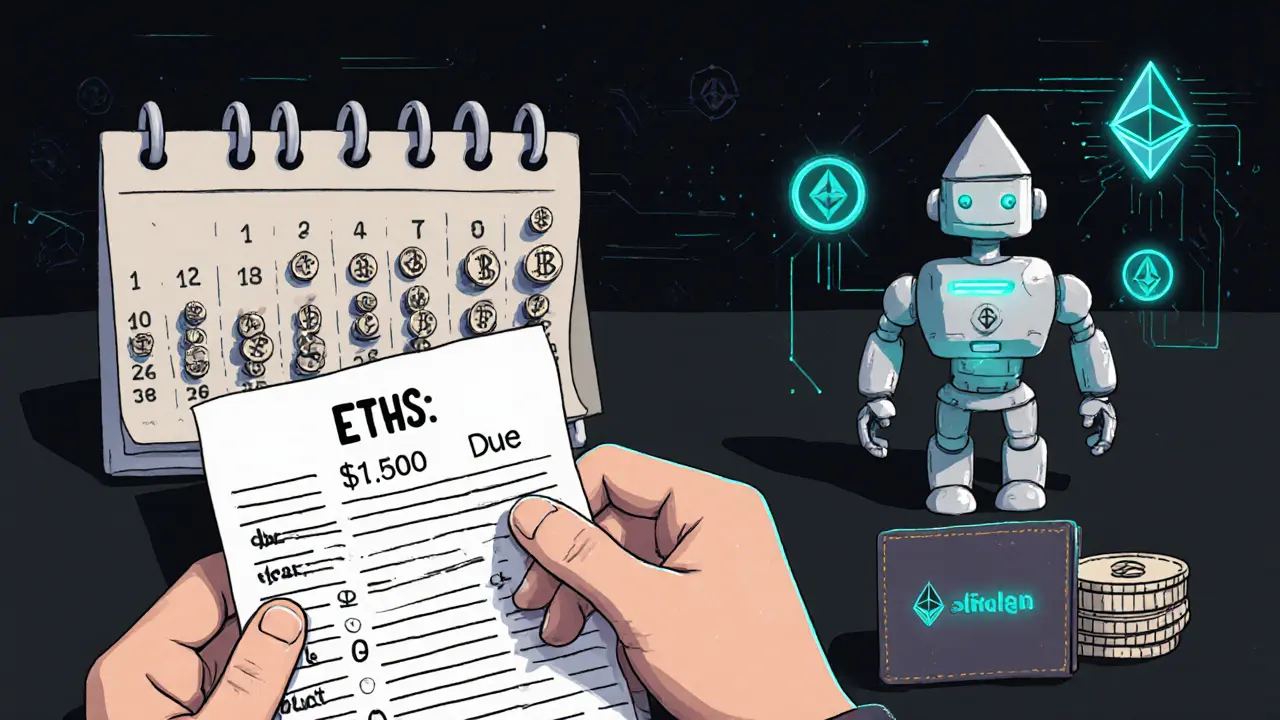How to Calculate Staking Rewards in Cryptocurrency Networks
 Jul, 28 2025
Jul, 28 2025
Staking Rewards Calculator
How It Works
This calculator uses the formula:
APY = (1 + r/n)n − 1
where:
r = periodic reward rate
n = compounding periods per year
Projected Rewards
Important Notes
Your actual rewards may differ based on:
- Network conditions and MEV (Maximum Extractable Value)
- Uptime of your validator
- Platform-specific fees and guarantees
- Price fluctuations
Risk Warning
Remember:
• Slashing risk: Validators offline >20 minutes lose stake
• Tax implications: Rewards are taxable income when received
• Platform risk: Exchanges may lock funds or fail
• Volatility risk: Guaranteed rates (e.g., 7-9%) can change
Staking rewards aren’t magic. They’re math. And if you don’t understand the math, you’re leaving money on the table-or worse, getting burned.
When you stake your crypto, you’re locking it up to help secure a blockchain network. In return, you earn more crypto. Simple, right? But the numbers behind that reward? They’re messy. They change. They depend on how many people are staking, how often the network pays out, whether your validator stays online, and even how much transaction fee money gets pulled from the chain. If you think staking is just picking a coin and watching your balance grow, you’re in for a surprise.
How Staking Rewards Actually Work
Staking rewards come from two main sources: block rewards and transaction fees. On Ethereum, for example, every time a new block is added to the chain, validators get paid in ETH. That’s the base reward. Then there’s MEV-Maximum Extractable Value. That’s the extra cash validators earn by reordering or including high-fee transactions in blocks. It’s not theoretical. It’s real money. In 2024, MEV added an average of 1.8% to 2.2% extra yield on top of base rewards for active validators.
But here’s the catch: not everyone gets the same reward. If your validator goes offline for more than 20 minutes, you get slashed. That means you lose a portion of your staked ETH. If you’re using a pool or exchange and their validator goes down, you still lose. You didn’t even know they were offline. That’s the risk you take when you don’t control the validator yourself.
The Math Behind the Numbers
The simplest way to estimate your reward is using APY-Annual Percentage Yield. It accounts for compounding, which matters because most blockchains pay out rewards every epoch (every 6.4 minutes on Ethereum). The formula is:
APY = (1 + r/n)ⁿ − 1
Where:
- r = the periodic reward rate (e.g., 0.0005 per epoch)
- n = number of compounding periods per year (52,560 for Ethereum)
Let’s say you stake 10 ETH. Ethereum’s base reward rate is around 4% annually. But with MEV, it’s closer to 5.8% right now. That’s not a guess. That’s what blockchain explorers like BeaconScan and Dune Analytics show for the last 90 days.
So 10 ETH at 5.8% APY = roughly 0.58 ETH earned in a year. But if you compound weekly, it’s actually 5.95%. That extra 0.15 ETH? That’s $50+ depending on price. It adds up.
Now, here’s where people get tripped up. If a platform says “9% APY,” that doesn’t mean the blockchain is paying 9%. It means they’re guaranteeing you 9%, even if the real rate is 7%. Coinhouse does this. So do some exchanges. They eat the difference. That’s fine-until the market crashes and they stop offering guarantees. Then you’re stuck with the real, lower rate.
Platform Differences Matter More Than You Think
Not all staking is equal. Here’s how three major approaches stack up:
| Platform Type | How Rewards Are Calculated | APY Range (2025) | Key Risk |
|---|---|---|---|
| Ethereum Validator (Self-Run) | Base reward + MEV + uptime bonus. Slashing for downtime. | 5.5% - 6.5% | Slashing, technical complexity |
| Exchange Staking (e.g., Coinbase, Kraken) | Pool-based. Rewards averaged across all users. No slashing risk to you. | 4.8% - 5.7% | Centralization, withdrawal delays |
| Guaranteed Rate (e.g., Coinhouse) | Fixed rate regardless of network changes. Platform absorbs volatility. | 7% - 9% (guaranteed) | Platform solvency risk |
| Other Chains (Solana, Polygon, Cardano) | Fixed or variable per protocol. Often higher APY but lower security. | 4% - 12% | Protocol risk, lower liquidity |
On Solana, you might see 7% APY. On Cardano, 3.5%. On Ethereum, 5.8%. But Solana’s network has crashed three times in 2024. Cardano’s rewards are slow to compound. Ethereum’s is stable but locked for months. You’re not just choosing a rate. You’re choosing a trade-off.
What No One Tells You About Lock-Ups and Taxes
When you stake ETH, you can’t withdraw it until you initiate an unbonding period. That’s 18-24 hours on Ethereum. But if you’re using an exchange, they might lock your ETH for 30 days after you request withdrawal. That’s not the blockchain’s fault. That’s their policy.
And taxes? In the U.S., the IRS still treats staking rewards as taxable income the moment you receive them-even if you don’t sell. So if you earn 0.5 ETH in rewards and ETH is at $3,000, you owe tax on $1,500. Even if the price drops to $2,000 next week, you still owe tax on the higher value. That’s a trap. Many people get hit with big tax bills they didn’t expect.
Canada and the UK tax staking like mining income. Germany? No tax if you hold for 10 years. The U.S. is a mess. A 2024 court case in Florida ruled that staking rewards shouldn’t be taxed until sold. That’s a win. But it’s not law yet. Don’t assume you’re safe.

How to Get Started Without Getting Screwed
Here’s how real people do it right:
- Start small. Stake 0.1 ETH or 50 SOL. See how it works. Watch the rewards appear. Check if they match what the calculator said.
- Use the platform’s built-in calculator. Coinbase, Kraken, and Lido all have them. Input your amount. Set the time. See the projected return. Then compare it to what blockchain explorers show.
- Don’t chase the highest APY. A 12% yield on a new chain could mean the protocol is printing new tokens to pay you. That’s inflation. That’s unsustainable. Stick to networks with real usage-Ethereum, Polygon, Solana.
- Track everything. Use a tool like Koinly or TokenTax. Export your staking transactions. Link them to your wallet. You’ll need this for taxes.
- Diversify. Don’t put all your ETH into one exchange. Split between Coinbase, Lido, and a self-run validator if you’re technical. Spread your risk.
One user on Reddit staked 20 ETH across three platforms in early 2024. One platform went offline for 12 hours. He lost 0.03 ETH in slashing. But the other two paid full rewards. His total APY was still 5.9%. He didn’t panic. He didn’t pull out. He just adjusted his next stake.
What’s Next for Staking Rewards?
Staking is evolving fast. In 2025, we’re seeing:
- Cross-chain staking-stake ETH and earn rewards in SOL or ADA through protocols like LayerZero.
- AI-powered validators-tools that auto-switch your stake to the highest-yielding validator every 24 hours.
- Regulatory clarity-the SEC is expected to issue formal guidance on staking rewards by mid-2025.
But the core math won’t change. Rewards still come from block creation. Still depend on uptime. Still compound. Still get taxed. The only thing getting better is the tools to track it.
Staking isn’t passive income. It’s active responsibility. You’re not just holding crypto-you’re helping run a global computer. And that comes with real math, real risks, and real rewards.